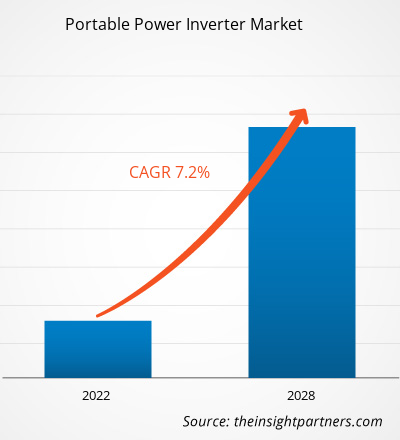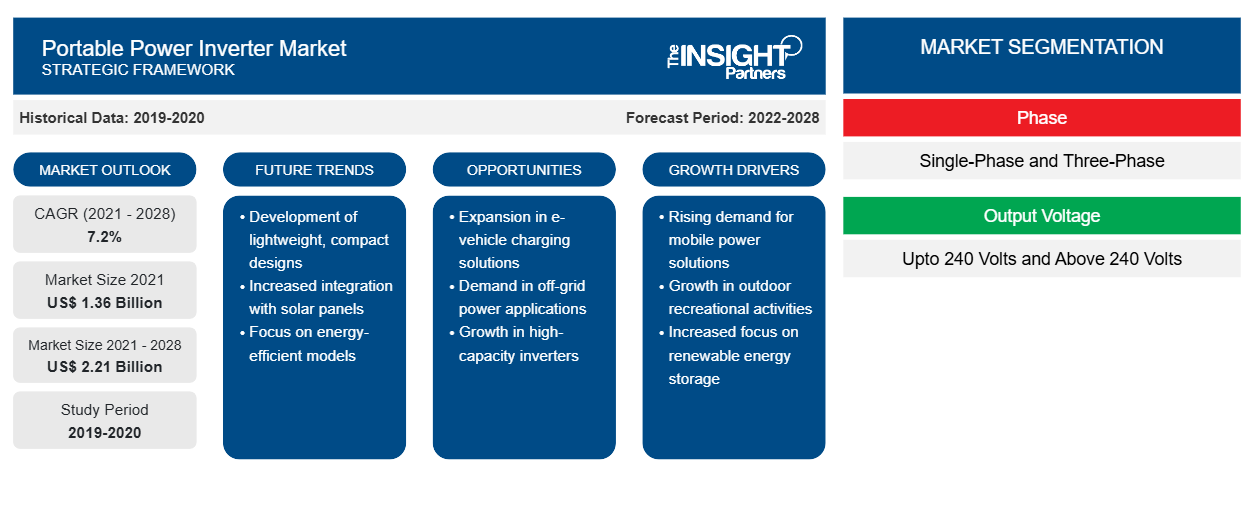휴대용 전력 인버터 시장은 2021년 1,359.21백만 달러에서 2028년 2,206.57백만 달러로 성장할 것으로 예상됩니다. 2021년에서 2028년까지 연평균 성장률 7.2% 로 증가할 것으로 추산됩니다 .
전력 인버터는 배터리의 DC 전력을 모든 종류의 장치를 작동하는 데 사용할 수 있는 기존 AC 전력으로 변경합니다. 인버터는 자동차 배터리 및 풍력 터빈 , 태양광 패널과 같은 기타 재생 에너지원을 사용하여 전기 장치를 충전하는 데 사용할 수 있습니다. 휴대용 전력 인버터는 광범위한 자동차 및 제조 산업에서 사용됩니다. 소켓에 꽂거나 퓨즈 패널을 사용하거나 배터리 단자에 직접 연결하여 전원을 공급합니다. 전기 자동차의 보급 증가, 레크리에이션 차량의 상업적 사용 증가, 태양광 발전의 급증하는 채택, 온실 가스(GHG ) 배출을 줄이기 위한 정부 이니셔티브의 증가는 휴대용 전력 인버터 시장을 주도하고 있습니다.
보고서는 유기적 및 무기적 성장 전략으로서 휴대용 전력 인버터 시장 의 중요한 개발 사항을 다룹니다 . 다양한 회사가 제품 출시, 제품 승인, 특허 및 이벤트와 같은 유기적 성장 전략에 집중하고 있습니다. 시장에서 목격된 무기적 성장 전략 활동은 인수, 파트너십 및 협업이었습니다. 이러한 활동은 시장 참여자의 사업 확장 및 고객 기반을 위한 길을 열었습니다. 이러한 참여자는 향후 몇 년 동안 휴대용 전력 인버터에 대한 수요가 증가함에 따라 수익성 있는 성장 기회를 얻을 것으로 예상됩니다.
귀하의 요구 사항에 맞게 이 보고서를 사용자 정의하세요
이 보고서의 일부 또는 국가 수준 분석, Excel 데이터 팩을 포함하여 모든 보고서에 대한 사용자 정의를 무료로 받을 수 있으며 신생 기업 및 대학을 위한 훌륭한 혜택과 할인 혜택을 이용할 수 있습니다.
-
이 보고서의 주요 시장 동향을 알아보세요.이 무료 샘플에는 시장 동향부터 추정 및 예측까지 다양한 데이터 분석이 포함됩니다.
COVID-19 팬데믹이 글로벌 휴대용 파워 인버터 시장에 미치는 영향
휴대용 전력 인버터는 최첨단 기술을 탑재하여 효율성이 향상되고 시스템 중복성이 높습니다. 광범위한 가정용 및 상업용 애플리케이션에 지속 가능한 에너지 솔루션을 제공할 수 있습니다. COVID-19로 인해 부과된 봉쇄는 이 시장의 글로벌 성장에 부정적인 영향을 미쳤습니다. 새로운 인버터 생산 지연, 용량 확장 예측 및 주요 업체의 가치 사슬에 대한 재정 문제로 인해 시장은 팬데믹 동안 느리게 성장했습니다. 대부분의 직원이 재택근무를 하면서 과잉 전기 생산으로 인해 휴대용 전력 인버터에 대한 수요가 크게 감소했고 제조 공장이 일시적으로 문을 닫았습니다. 이는 2020년 휴대용 전력 인버터 시장 성장에 방해가 되었습니다.
휴대용 파워 인버터 시장 통찰력
주거 부문 수요 지속 증가
주거 부문에서 개인용 인버터를 채택하는 것은 수십 년 동안 이어져 왔습니다. 이 요인은 휴대용 전력 인버터 시장 성장을 주도하는 주요 요인 중 하나입니다. 현재 상황에서 휴대용 전력 인버터에 대한 관심은 휴대성과 낮은 에너지 소비 이점으로 인해 엄청나게 증가했습니다. 이러한 인버터의 다양한 모델에 대한 관심이 증가하면서 시장이 크게 성장하고 있습니다. 또한 휴대용 전력 인버터의 채택은 주거 부문의 최종 사용자 사이에서 태양광 PV 휴대용 인버터의 조달이 증가함에 따라 수년에 걸쳐 증가할 것으로 예상되며, 이는 휴대용 전력 인버터 시장 규모를 촉진합니다.
전 세계적으로 구매되는 가전제품의 수가 증가하는 것은 전력 인버터에 대한 수요 증가의 주요 요인 중 하나입니다. 지난 몇 년 동안 재택근무 시나리오는 지속적인 전원 공급이 필요한 가정에서 노트북, 데스크탑 및 기타 가전제품의 사용이 증가했음을 보여주었습니다. 이로 인해 전 세계적으로 휴대용 전력 인버터에 대한 필요성과 채택이 눈에 띄게 증가했으며, 이는 휴대용 전력 인버터 시장 성장을 더욱 촉진하고 있습니다.
최근 몇 년 동안 갑작스러운 정전의 불확실성은 주거 부문에서 전력 인버터에 대한 수요에 반영되었습니다. 따라서 휴대성, 낮은 전력 소비, 정전 중 전자 작동을 지원하기 위한 인버터의 필요성과 같은 요인을 결합하면 전력 인버터의 채택이 증가하고, 최근에는 전력 인버터의 휴대형 버전이 증가하고 있습니다. 이는 휴대형 전력 인버터 시장 규모를 견인하고 있습니다.
단계별 시장 통찰력
위상에 따라 휴대용 전력 인버터 시장은 단상과 3상으로 구분됩니다. 2021년에는 단상 세그먼트가 시장을 주도했습니다. 주거용 애플리케이션에 대한 태양광 PV 배치가 증가함에 따라 단상 인버터 채택이 증가하고 있습니다. 정부는 재생 에너지를 통합하기 위해 주거 부문에 대한 세금 혜택 및 자회사 형태로 인센티브를 제공하고 있습니다.
출력 전압 기반 시장 통찰력
출력 전압을 기준으로 휴대용 전력 인버터 시장은 최대 240볼트와 240볼트 이상으로 나뉩니다. 2021년에는 최대 240볼트 세그먼트가 가장 큰 시장 점유율을 차지했습니다. 인버터는 원래 AC를 DC로 변환하는 대형 전기 기계 장치였던 "컨버터"의 역기능을 제공합니다. 인버터의 부하가 변경되더라도 전력 인버터의 AC 출력 전압은 일반적으로 배전 수준에서 일반적으로 120 또는 240VAC인 그리드 라인 전압과 동일하게 제어됩니다.
휴대용 파워 인버터 시장 지역 통찰력
Insight Partners의 분석가들은 예측 기간 동안 휴대용 전력 인버터 시장에 영향을 미치는 지역적 추세와 요인을 철저히 설명했습니다. 이 섹션에서는 또한 북미, 유럽, 아시아 태평양, 중동 및 아프리카, 남미 및 중미의 휴대용 전력 인버터 시장 세그먼트와 지리에 대해서도 설명합니다.

- 휴대용 전원 인버터 시장에 대한 지역별 데이터 얻기
휴대용 파워 인버터 시장 보고서 범위
| 보고서 속성 | 세부 |
|---|---|
| 2021년 시장 규모 | 13억 6천만 달러 |
| 2028년까지 시장 규모 | 22억 1천만 달러 |
| 글로벌 CAGR (2021-2028) | 7.2% |
| 역사적 데이터 | 2019-2020 |
| 예측 기간 | 2022-2028 |
| 다루는 세그먼트 |
단계별로
|
| 포함된 지역 및 국가 |
북아메리카
|
| 시장 선도 기업 및 주요 회사 프로필 |
|
휴대용 파워 인버터 시장 참여자 밀도: 비즈니스 역학에 미치는 영향 이해
휴대용 전력 인버터 시장은 소비자 선호도의 변화, 기술 발전, 제품의 이점에 대한 인식 증가와 같은 요인으로 인해 최종 사용자 수요가 증가함에 따라 빠르게 성장하고 있습니다. 수요가 증가함에 따라 기업은 제품을 확장하고, 소비자의 요구를 충족하기 위해 혁신하고, 새로운 트렌드를 활용하여 시장 성장을 더욱 촉진하고 있습니다.
시장 참여자 밀도는 특정 시장이나 산업 내에서 운영되는 회사나 기업의 분포를 말합니다. 주어진 시장 공간에 얼마나 많은 경쟁자(시장 참여자)가 존재하는지 그 규모나 전체 시장 가치에 비해 나타냅니다.
휴대용 전원 인버터 시장에서 운영되는 주요 회사는 다음과 같습니다.
- 코브라 일렉트로닉스 주식회사
- 에너자이저 홀딩스 주식회사
- 키세테크놀로지 주식회사
- 코텍
- 랠리 제조
면책 조항 : 위에 나열된 회사는 어떤 특별한 순서에 따라 순위가 매겨지지 않았습니다.

- 휴대용 전원 인버터 시장의 주요 주요 업체 개요를 알아보세요
애플리케이션 기반 시장 통찰력
휴대용 전력 인버터 시장은 응용 프로그램을 기준으로 주거용, 상업용 및 산업용으로 세분화됩니다. 2021년에는 주거용 세그먼트가 가장 큰 시장 점유율을 차지했습니다. 주거용 사용자가 태양광 PV를 점점 더 많이 채택함에 따라 회사는 고급 기능을 갖춘 인버터를 제공하고 있습니다. 예를 들어, 2020년 5월 Huawei Technologies Co., Ltd.는 주거용 애플리케이션을 위한 AI 기반 아크 보호 기술을 갖춘 단상 및 3상 인버터인 Smart Energy Controllers를 출시한다고 발표했습니다.
휴대용 전력 인버터 시장에서 활동하는 업체들은 합병, 인수, 시장 이니셔티브와 같은 전략을 채택하여 시장에서의 입지를 유지합니다. 주요 업체들의 몇 가지 개발 사항은 다음과 같습니다.
- 2020년 9월, Ring은 두 제품이 Auto Express의 최신 에디션에서 인버터 테스트에서 수상했다고 발표했습니다. RINVU300 PowerSource 300W Compact Inverter는 Best Buy 상을 수상하고 왕관을 지켰으며, RINVU500 PowerSource 500W Compact Inverter는 추천을 받았습니다.
- 2022년 1월, 이튼과 삼성은 삼성의 SmartThings Energy 플랫폼의 가정 에너지 관리 및 모니터링 기능을 확장하기 위한 새로운 파트너십을 통해 이 기회를 가속화할 예정입니다.
회사 프로필
휴대용 전원 인버터 시장에서 활동하는 주요 기업에는 Cobra Electronics Corporation, ENERGIZER HOLDINGS, INC., Kisae Technology Inc., COTEK, Rally Manufacturing, EXELTECH, OSRAM GmbH, Ring Automotive Ltd., Growatt New Energy, Eaton이 있습니다. 또한, 휴대용 전원 인버터 시장의 전반적인 상황을 이해하기 위해 여러 지역에 걸친 다른 기업도 연구했습니다.
- 과거 분석(2년), 기준 연도, CAGR을 포함한 예측(7년)
- PEST 및 SWOT 분석
- 시장 규모 가치/거래량 - 글로벌, 지역, 국가
- 산업 및 경쟁 환경
- Excel 데이터세트
최근 보고서
관련 보고서
사용 후기
구매 이유
- 정보에 기반한 의사 결정
- 시장 역학 이해
- 경쟁 분석
- 고객 인사이트
- 시장 예측
- 위험 완화
- 전략 기획
- 투자 타당성 분석
- 신흥 시장 파악
- 마케팅 전략 강화
- 운영 효율성 향상
- 규제 동향에 발맞춰 대응























 무료 샘플 받기 - 휴대용 전력 인버터 시장
무료 샘플 받기 - 휴대용 전력 인버터 시장